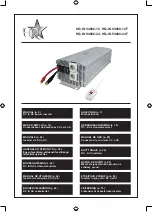
100693 - 7500W ELECTRIC START GENERATOR
OPERATION
19
"
NOTICE
For gasoline restarts with hot engine in hot ambient >
86°F (30°C),
keep choke in 75% of the “CHOKE” position for
only 1 pull of the recoil cord. After first pull, move choke to
“RUN” position for up to 3 pulls of the recoil cord. Too much
choke leads to spark plug fouling/engine flooding due to lack
of incoming air. This will cause the engine not to start.
"
NOTICE
For gas starting in cold ambient temperature < 59°F
(15°C),
the choke must be in 100% of the “CHOKE” position
for manual start procedures. Do not over-choke. As soon as
engine starts, gradually move the choke lever to the “RUN”
position over a 2-5 second duration.
"
NOTICE
If the engine starts but does not run make certain that the
generator is on a flat, level surface. The engine is equipped
with a low oil sensor that will prevent the engine from running
when the oil level falls below a critical threshold.
Connecting Electrical Loads
Let the engine stabilize and warm up for a few minutes after
starting.
Plug in and turn on the desired 120 or 240 (if applicable) Volt AC
single phase, 60 Hz electrical loads.
–
DO NOT connect 3-phase loads to the generator.
–
DO NOT overload the generator.
!
WARNING
Connecting a generator to your electric utility company’s
power lines or to another power source may be against the
law. In addition this action, if done incorrectly, could damage
your generator and appliances and could cause serious injury
or even death to you or a utility worker who may be working
on nearby power lines. If you plan to run a portable electric
generator during an outage, please notify your electric utility
company immediately and remember to plug your appliances
directly into the generator. Do not plug the generator into
any electric outlet in your home. Doing so could create
a connection to the utility company power lines. You are
responsible for ensuring that your generator’s electricity does
not feed back into the electric utility power lines.
If the generator will be connected to a building electrical
system, consult your local utility company or a qualified
electrician. Connections must isolate generator power from
utility power and must comply with all applicable laws and
codes.
Do Not Overload Generator
Capacity
Follow these simple steps to calculate the running and starting
watts necessary for your purposes:
1. Select the electrical devices you plan on running at the same
time.
2. Total the running watts of these items. This is the amount of
power you need to keep your items running.
3. Identify the highest starting wattage of all devices identified
in step 1. Add this number to the number calculated in step 2.
Starting wattage is the surge of power needed to start some
electric driven equipment. Following the steps listed under
“Power Management” will guarantee that only one device will
be starting at a time.
Power Management
Use the following formula to convert voltage and amperage to
watts:
Volts
×
Amps = Watts
To prolong the life of your generator and attached devices, follow
these steps to add electrical load:
1. Start the generator with no electrical load attached.
2. Allow the engine to run for several minutes to get up to
temperature.
3. Plug in and turn on the first item. It is best to attach the item
with the largest load first.
4. Allow the engine to stabilize.
5. Plug in and turn on the next item.
6. Allow the engine to stabilize.
7. Repeat steps 5-6 for each additional item.
"
NOTICE
Never exceed the specified capacity when adding loads to the
generator.
















































